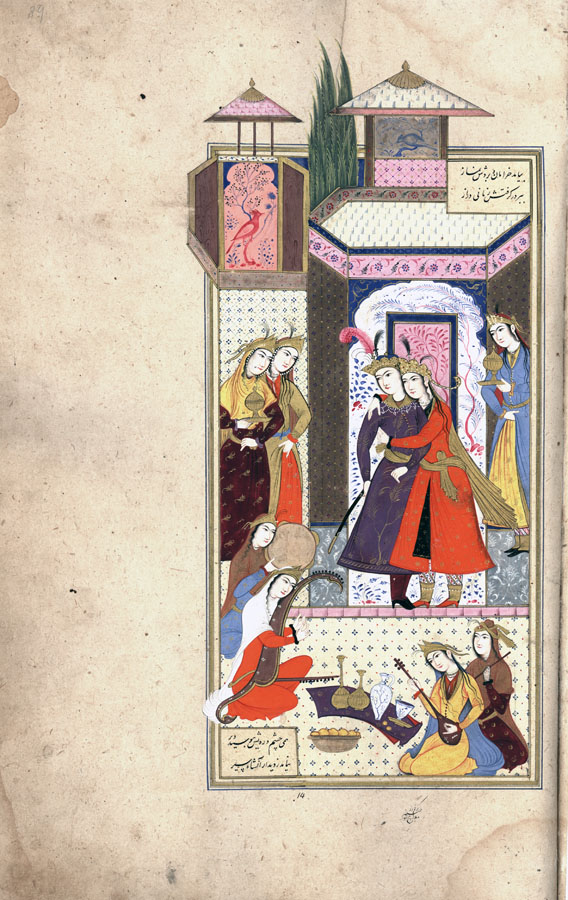Siyāvoš in Sudāba's Dwellings
It is not possible to ascertain from the painting whether it is Siyāvoš’s first, second, or third visit to the harām that is depicted. Near the center of the painting, Sudāba is standing with her arms wrapped around Siyāvoš, who, standing next to her, tries to turn away from her advances, interposing his left arm between them in an attempt to hold her off, or to break free from her embrace. Sudāba is portrayed with long black hair and a jewel-studded crown, a long red robe loosely knotted at the waist with a sash, a train or cape that flows down her back, and boots. Siyāvoš wears a full length purple robe decorated with light wisps of foliage, boots, a jewelled crown adorned with feathers, and a sword hung loosely from his belt.
The setting is apparently the harām of the royal palace, and the pair are portrayed in front of a white multilobe-arched panel with foliate decoration that is set into the wall of a tiled, hexagonal shaped structure. This structure has a roof or balcony at the top, and is surmounted by a small pavilion enclosing a bird on a branch, or panel painting thereof. A smaller pavilion, also with a panel below it depicting a bird in a tree, appears further to the left. Between the pavilions are the tops of two closely placed cypress trees. Behind Sudāba, on the extreme right, is a female servant in a long dress and a tiara on her head, carrying a tray with a decanter. On the opposite side are two more female servants similarly dressed, one of whom is carrying an identical tray and decanter. The foreground, a tiled floor, is shown typically in plan. On it are seated four female musicians. Among the musical instruments can be seen a tambourine, harp, and lute. Spread on the floor between the two groups of musicians is a cloth on which several decanters and a bowl of fruit are set.
There are only four short lines of text accompanying the painting: two are in a single column in the upper right, and two more in the lower left. A rectangular ruled frame encloses illustration and text except for two small pavilions and cypress trees that protrude into the upper margin, and a shutter-like extension that protrudes into the left margin near the top. The painting is signed in the lower margin, just to the right of center, in miniscule characters in Moʿin’s hand: raqam zad kamina moʿin-e moṣavver. The inscription is not dated.
Painting references:
Welch, AK4_1978, p.90, Ms.22, folio 89r (illustrated).
Text references:
Warner, II, pp.202-11; Mohl, II, pp.168-78; Levy, pp.85-87
Robert Eng
Last Updated: June 27, 2011 | Originally published: June 27, 2011
